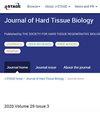50 μM氟化钠抑制衰老诱导的小鼠牙槽骨吸收
IF 0.4
4区 医学
Q4 ENGINEERING, BIOMEDICAL
引用次数: 1
摘要
摄入过量的全身氟化物会导致骨稳态的生理和病理紊乱。我们和其他人已经证实,在细胞和动物模型中,用50 μM氟化钠(NaF)治疗骨重塑是安全有效的。本研究旨在研究50 μM NaF对巨噬细胞驱动的破骨细胞形成的影响,并表征50 μM NaF对衰老过程中牙槽骨吸收的作用。在50 μM NaF存在或不存在的情况下,用RANKL处理小鼠RAW264.7单核细胞。采用实时定量RT-PCR检测参与破骨细胞诱导机制的组织蛋白酶K (Cathepsin K)和核因子活化t细胞胞浆1 (NFATc1) mRNA表达水平。采用50 μM naf处理的实验性衰老小鼠模型来证实牙槽骨吸收。采用Micro-CT评估骨丢失情况,免疫组化检测牙周组织中RANKL和Cathepsin K蛋白表达水平。50 μM NaF处理RAW264.7细胞抑制破骨细胞生成。Micro-CT结果证实,50 μM NaF治疗可减轻老年患者牙槽骨吸收。免疫组化分析显示,50 μM naf处理小鼠衰老过程中RANKL和组织蛋白酶K的表达水平下降。综上所述,这些结果提供了有趣的实验线索,表明50 μM NaF在牙槽骨老化过程中具有抗骨吸收剂的作用。本文章由计算机程序翻译,如有差异,请以英文原文为准。
Treatment with 50 μM Sodium Fluoride Suppresses Aging-Induced Alveolar Bone Resorption in Mice
Ingestion of excess systemic fluoride results in physiological and pathological disturbances of bone homeostasis. We and others have established that treatment with 50 μM sodium fluoride (NaF) is safe and effective for bone remodeling in cellular and animal models. This study aimed to study the effects of treatment with 50 μM NaF on macrophage-driven osteoclastogenesis and to characterize the function of 50 μM NaF in alveolar bone resorption during aging. Murine RAW264.7 monocytic cells were treated with RANKL in the presence or absence of 50 μM NaF. The mRNA expression levels of Cathepsin K and nuclear factor-activated T-cell cytoplasmic 1 (NFATc1), which are involved in the mechanism of osteoclast induction, were measured using quantitative real time RT-PCR. An experimental 50 μM NaF-treated aging mouse model was used to confirm alveolar bone resorption. Micro-CT was used to assess bone loss and immunohistochemistry was performed to detect the protein expression levels of RANKL and Cathepsin K in periodontal tissues. Treatment of RAW264.7 cells with 50 μM NaF repressed osteoclastogenesis. Micro-CT results confirmed that treatment with 50 μM NaF alleviated alveolar bone resorption in aging. Immunohistochemical analysis revealed decreased expression levels of RANKL and cathepsin K in 50 μM NaF-treated mice during aging. Taken together, these results contribute fascinating experimental clues that 50 μM NaF has the potential to function as an anti-resorptive agent during alveolar bone aging.
求助全文
通过发布文献求助,成功后即可免费获取论文全文。
去求助
来源期刊

Journal of Hard Tissue Biology
ENGINEERING, BIOMEDICAL-
CiteScore
0.90
自引率
0.00%
发文量
28
审稿时长
6-12 weeks
期刊介绍:
Information not localized
 求助内容:
求助内容: 应助结果提醒方式:
应助结果提醒方式:


